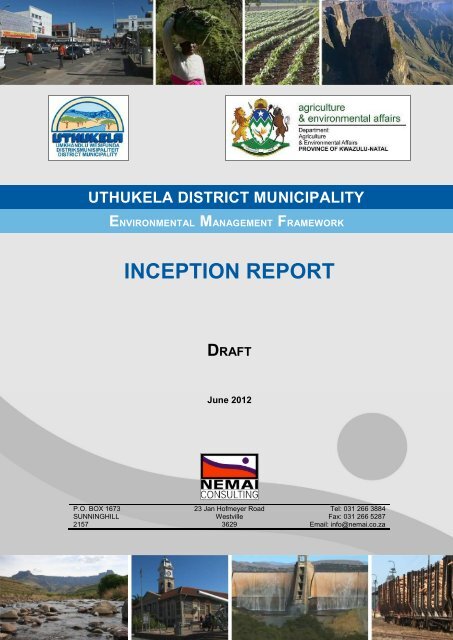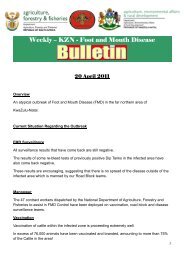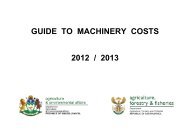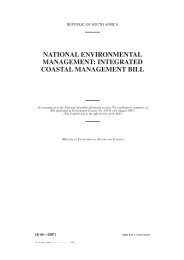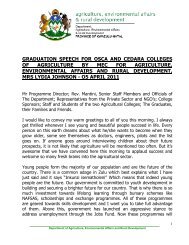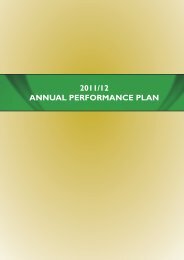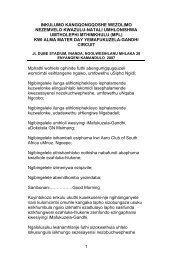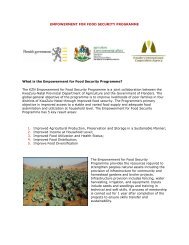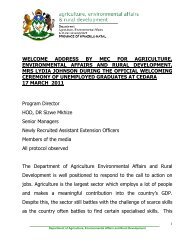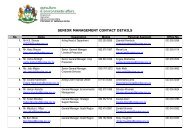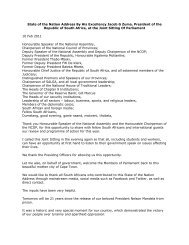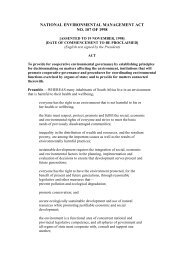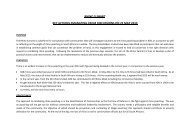INCEPTION REPORT - Department of Agriculture and ...
INCEPTION REPORT - Department of Agriculture and ...
INCEPTION REPORT - Department of Agriculture and ...
You also want an ePaper? Increase the reach of your titles
YUMPU automatically turns print PDFs into web optimized ePapers that Google loves.
UTHUKELA DISTRICT MUNICIPALITY<br />
ENVIRONMENTAL MANAGEMENT FRAMEWORK<br />
<strong>INCEPTION</strong> <strong>REPORT</strong><br />
DRAFT<br />
June 2012<br />
P.O. BOX 1673<br />
SUNNINGHILL<br />
2157<br />
23 Jan H<strong>of</strong>meyer Road<br />
Westville<br />
3629<br />
Tel: 031 266 3884<br />
Fax: 031 266 5287<br />
Email: info@nemai.co.za
uThukela DM ENVIRONMENTAL MANAGEMENT FRAMEWORK<br />
TITLE AND APPROVAL PAGE<br />
Title:<br />
uThukela District Municipality Environmental Management Framework:<br />
Inception Report (Draft)<br />
Authors:<br />
Nicky Naidoo; Donavan Henning<br />
Status <strong>of</strong> Report: DRAFT<br />
First Issue: 11 June 2012<br />
Final Issue:<br />
Consultants:<br />
Approved for Consultants:<br />
………………………………………<br />
N. Naidoo<br />
Nemai Consulting - Study Leader<br />
Client:<br />
Approved for the KZN DAEA:<br />
…………………………………………………<br />
D. Gwede<br />
KZN DAEA - Study Leader<br />
Approved for the uThukela District Municipality:<br />
…………………………………………………<br />
B Khoza<br />
uThukela District Municipality - Study Leader<br />
Draft Inception Report (June 2012)<br />
Page i
uThukela DM ENVIRONMENTAL MANAGEMENT FRAMEWORK<br />
AMENDMENTS PAGE<br />
Date Nature <strong>of</strong> Amendment Amendment No. Signature<br />
11/06/12 First Draft for Client Review 0<br />
Draft Inception Report (June 2012)<br />
Page ii
uThukela DM ENVIRONMENTAL MANAGEMENT FRAMEWORK<br />
TABLE OF CONTENTS<br />
TITLE AND APPROVAL PAGE ..................................................................................................... i<br />
AMENDMENTS PAGE .................................................................................................................. ii<br />
TABLE OF CONTENTS ............................................................................................................... iii<br />
LIST OF ACRONYMS & ABBREVIATIONS .................................................................................. v<br />
1. INTRODUCTION ................................................................................................................ 1<br />
2. BACKGROUND ................................................................................................................. 2<br />
3. TERMS OF REFERENCE .................................................................................................. 4<br />
4. SCOPE & EXTENT OF WORK .......................................................................................... 4<br />
5. PROJECT MANAGEMENT PLAN ..................................................................................... 6<br />
5.1.1 Meetings ................................................................................................................ 6<br />
5.1.2 Points <strong>of</strong> Contact ................................................................................................... 7<br />
5.1.3 Progress Reports ................................................................................................... 7<br />
5.1.4 Management <strong>of</strong> Specialists .................................................................................... 8<br />
5.1.5 Financial Management ........................................................................................... 9<br />
5.1.6 Document Control .................................................................................................. 9<br />
5.1.7 Close-out Report ...................................................................................................10<br />
6. Project Team <strong>and</strong> Methodology .................................................................................... 10<br />
6.1 Project Team ................................................................................................................10<br />
6.2 Methodology .................................................................................................................11<br />
6.2.1 Project Inception ...................................................................................................12<br />
6.2.2 Information Gathering ...........................................................................................12<br />
6.2.3 Public Participation Process..................................................................................14<br />
6.2.4 Status Quo Assessment (WHERE ARE WE NOW?) ............................................15<br />
6.2.5 Desired State <strong>of</strong> the Environment (WHERE DO WE WANT TO BE?) ..................19<br />
6.2.6 Management Zones (HOW DO WE GET THERE?) ..............................................20<br />
6.2.7 Strategic Environmental Management Plan (HOW DO WE GET THERE?) ..........21<br />
6.2.8 Project Geographic Information System ................................................................23<br />
7. PROJECT DELIVERABLES ............................................................................................ 24<br />
8. PROJECT PROGRAMME ............................................................................................... 24<br />
9. PROJECT COMMUNICATION & STAKEHOLDER ENGAGEMENT PLAN .................... 26<br />
10. PROJECT BUDGET & TIMEFRAMES ............................................................................ 29<br />
11. SKILLS & KNOWLEDGE TRANSFER PROGRAMME .................................................... 29<br />
12. ROLES & RESPONSIBILITIES ....................................................................................... 30<br />
13. ADOPTION & APPROVAL OF FINAL PRODUCT .......................................................... 31<br />
Draft Inception Report (June 2012)<br />
Page iii
uThukela DM ENVIRONMENTAL MANAGEMENT FRAMEWORK<br />
14. PROJECT MONITORING & <strong>REPORT</strong>ING ....................................................................... 31<br />
15. Contractual Agreement between Client <strong>and</strong> Service Provider .................................... 31<br />
16. REFERENCES ................................................................................................................. 31<br />
LIST OF TABLES<br />
TABLE 1: INFORMATION METADATA MATRIX 9<br />
TABLE 2: PROJECT TEAM MEMBERS 10<br />
TABLE 3: TYPE OF INFORMATION TO BE CONSIDERED 14<br />
TABLE 4: SUMMARY OF DETAILED ASSESSMENTS 17<br />
TABLE 5: GUIDE FOR WEIGHTING ENVIRONMENTAL FEATURES 20<br />
TABLE 6: PUBLIC PARTICIPATION OUTLINE 26<br />
TABLE 7: SUMMARY OF PROJECT BUDGET 29<br />
TABLE 8: ROLES AND RESPONSIBILITIES – EMF DEVELOPMENT STAGE 30<br />
LIST OF FIGURES<br />
FIGURE 1: UTDM NATIONAL AND PROVINCIAL GEOGRAPHICAL CONTEXT 1<br />
FIGURE 2: UTDM LMS 2<br />
FIGURE 3: EMF COMPONENTS 5<br />
FIGURE 4: BROAD OVERVIEW OF EMF DEVELOPMENT PROCESS 11<br />
FIGURE 5: DETERMINING SENSITIVITY BY INTEGRATING BASE LAYERS 19<br />
FIGURE 6: EXAMPLE OF SEMP INDICATING THE LEVEL OF ASSESSMENT REQUIRED PER ZONE<br />
22<br />
FIGURE 7: UTDM EMF PROGRAMME (VERSION 1, 31 MAY 2012) 25<br />
LIST OF APPENDICES<br />
APPENDIX A :<br />
APPENDIX B :<br />
MINUTES OF <strong>INCEPTION</strong> MEETING<br />
DETAILED COST BREAKDOWN<br />
Draft Inception Report (June 2012)<br />
Page iv
uThukela DM ENVIRONMENTAL MANAGEMENT FRAMEWORK<br />
LIST OF ACRONYMS & ABBREVIATIONS<br />
BID<br />
COGTA<br />
DAFF<br />
DEA<br />
DEAT<br />
DAEA<br />
DMR<br />
DWA<br />
ECZ<br />
EIA<br />
EMF<br />
EMP<br />
GIS<br />
GN<br />
IDP<br />
I&APs<br />
LM<br />
Background Information Document<br />
<strong>Department</strong> <strong>of</strong> Cooperative Governance <strong>and</strong> Traditional Affairs<br />
<strong>Department</strong> <strong>of</strong> <strong>Agriculture</strong>, Forestry <strong>and</strong> Fisheries<br />
<strong>Department</strong> <strong>of</strong> Environmental Affairs<br />
<strong>Department</strong> <strong>of</strong> Environmental Affairs <strong>and</strong> Tourism<br />
<strong>Department</strong> <strong>of</strong> <strong>Agriculture</strong> <strong>and</strong> Environmental Affairs<br />
<strong>Department</strong> <strong>of</strong> Minerals Resources<br />
<strong>Department</strong> <strong>of</strong> Water Affairs<br />
Environmental Constraint Zone<br />
Environment Impact Assessment<br />
Environmental Management Framework<br />
Environmental Management Plan<br />
Geographical Information System<br />
Government Notice<br />
Integrated Development Plan<br />
Interested <strong>and</strong> Affected Parties<br />
Local Municipality<br />
NEMA National Environmental Management Act (Act No. 107 <strong>of</strong> 1998)<br />
PMT<br />
PPP<br />
PSC<br />
PSEDS<br />
SDF<br />
SEMP<br />
ToR<br />
UTDM<br />
Project Management Team<br />
Public Participation Process<br />
Project Steering Committee<br />
Provincial Spatial Economic Development Strategy<br />
Spatial Development Framework<br />
Strategic Environmental Management Plan<br />
Terms <strong>of</strong> Reference<br />
uThukela District Municipality<br />
Draft Inception Report (June 2012)<br />
Page v
uThukela DM ENVIRONMENTAL MANAGEMENT FRAMEWORK<br />
1. INTRODUCTION<br />
The uThukela District Municipality (UTDM), in partnership with the KwaZulu-Natal <strong>Department</strong> <strong>of</strong><br />
<strong>Agriculture</strong> <strong>and</strong> Environmental Affairs (DAEA), embarked on a process to develop an<br />
Environmental Management Framework (EMF) for the district. Nemai Consulting was appointed<br />
to prepare the UTDM EMF.<br />
According to the EMF Regulations (Government Notice No. R547 <strong>of</strong> 18 June 2010), an EMF is a<br />
study <strong>of</strong> the biophysical <strong>and</strong> socio-cultural systems <strong>of</strong> a geographically defined area to reveal<br />
where specific l<strong>and</strong> uses may best be practiced <strong>and</strong> to <strong>of</strong>fer performance st<strong>and</strong>ards for<br />
maintaining appropriate use <strong>of</strong> such l<strong>and</strong>. An EMF includes a framework <strong>of</strong> spatially represented<br />
information connected to significant enviornmental (i.e. ecological, social <strong>and</strong> economic)<br />
parameters, such as ecology, hydrology, infrastructure <strong>and</strong> services. A key function <strong>of</strong> an EMF is<br />
to proactively identify areas <strong>of</strong> potential conflict between development proposals <strong>and</strong><br />
critical/sensitive environments (DEAT, 1998).<br />
uThukela (district code DC23), which is regarded as the soul <strong>of</strong> the Zulu Kingdom, is located in<br />
the western boundary <strong>of</strong> KwaZulu-Natal (KZN) (see Figure 1).<br />
Figure 1: UTDM National <strong>and</strong> Provincial Geographical Context<br />
Draft Inception Report (June 2012) Page 1
uThukela DM ENVIRONMENTAL MANAGEMENT FRAMEWORK<br />
Apart from the District Management Area, uThukela encompasses<br />
the following local municipalities:<br />
Emnambithi Local Municipality (LM);<br />
Okhahlamba LM;<br />
Imbabazane LM;<br />
Indaka LM; <strong>and</strong><br />
Umtshezi LM.<br />
At approximately 11,500 km 2 ,<br />
the District is predominately<br />
rural <strong>and</strong> around 35% <strong>of</strong> the<br />
area is classified as either<br />
“tribal” or peri-urban. Ladysmith<br />
<strong>and</strong> Estcourt constitute the two major<br />
towns <strong>and</strong> economic hubs within the<br />
municipality.<br />
Figure 2: UTDM LMs<br />
This document serves as the Inception Report for the development <strong>of</strong> an EMF for UTDM, <strong>and</strong> it is<br />
based on the Terms <strong>of</strong> Reference (ToR), Nemai Consulting’s proposal <strong>and</strong> the outcome <strong>of</strong> the<br />
Inception Meeting held on 20 March 2012.<br />
2. BACKGROUND<br />
Imperatives for promoting sustainable l<strong>and</strong> use within the UTDM include (amongst others):<br />
uThukela comprises exceptional terrestrial <strong>and</strong><br />
aquatic biodiversity, species richness <strong>and</strong><br />
endemicity;<br />
The District is endowed with rich cultural <strong>and</strong><br />
historical resources;<br />
The Ukhahlamba Drakensberg mountain range is a World<br />
Heritage Site <strong>and</strong> forms part <strong>of</strong> the Maloti-Drakensberg<br />
Transfrontier Peace Park between Lesotho <strong>and</strong> South Africa;<br />
Unemployment <strong>and</strong> poverty are at a high level;<br />
Draft Inception Report (June 2012) Page 2
uThukela DM ENVIRONMENTAL MANAGEMENT FRAMEWORK<br />
<br />
<br />
<br />
<br />
<br />
<br />
The two national routes, namely the N3 <strong>and</strong> N11, that traverse the District form a critical link<br />
between uThukela <strong>and</strong> provincial, national <strong>and</strong> international destinations;<br />
Provision <strong>of</strong> sustainable infrastructure, water <strong>and</strong> sanitation services <strong>and</strong> eradication <strong>of</strong> the<br />
backlog are key priorities for the District;<br />
The District <strong>of</strong>fers a host <strong>of</strong> tourism opportunities, such as the Drakensberg Mountains, Cable<br />
Way-Mnweni Valley, Zulu Gateway, World Heritage Site, Cannibal Route, <strong>and</strong> Dinosaur<br />
Valley;<br />
UTDM contains the basis <strong>of</strong> the Tugela-Vaal water scheme <strong>and</strong> good water resources;<br />
Although commercial farming is well developed, the full agricultural potential <strong>of</strong> UTDM still<br />
needs to be unlocked;<br />
Pro-active environmental management in the District is required.<br />
In order to address the triggers for sustainable development in the UTDM <strong>and</strong> the priority<br />
environmental opportunities <strong>and</strong> constraints, the specific objectives <strong>of</strong> the EMF will include the<br />
following:<br />
1. To facilitate decision-making to ensure sustainable management <strong>of</strong> natural resources;<br />
2. To provide strategic guidance on both environmental, economic <strong>and</strong> social issues in the<br />
District;<br />
3. To identify environmentally sensitive areas;<br />
4. To identify the environmental <strong>and</strong> development opportunities <strong>and</strong> constraints;<br />
5. To assess the economic <strong>and</strong> environmental potential <strong>of</strong> the area;<br />
6. To provide a decision support system in respect <strong>of</strong> environmental issues <strong>and</strong> priorities in<br />
UTDM;<br />
7. To formulate a strategy that will incorporate issues such as l<strong>and</strong> use, planning <strong>and</strong> sensitive<br />
environmental resources; <strong>and</strong><br />
8. To include existing policies as frameworks for establishing values, guidelines <strong>and</strong> st<strong>and</strong>ards<br />
for future developments.<br />
In its formal context, the EMF that is adopted by the Minister or MEC will be taken into<br />
consideration when reviewing applications for environmental authorisation in or affecting the<br />
UTDM.<br />
Draft Inception Report (June 2012) Page 3
uThukela DM ENVIRONMENTAL MANAGEMENT FRAMEWORK<br />
3. TERMS OF REFERENCE<br />
At the stage <strong>of</strong> completing the Inception Report, Nemai Consulting can confirm that there will be<br />
no deviation from the approach advocated in its proposal, which is aligned with the ToR.<br />
However, deviations may occur during the execution <strong>of</strong> the EMF through input <strong>and</strong> comments<br />
received from the Project Management Team (PMT), Project Steering Committee (PSC),<br />
environmental authorities <strong>and</strong> Interested <strong>and</strong> Affected Parties (I&Aps) <strong>and</strong> through the findings <strong>of</strong><br />
specialist studies.<br />
4. SCOPE & EXTENT OF WORK<br />
The scope <strong>of</strong> work is to assist the UTDM, KZN DAEA <strong>and</strong> other sector departments to develop an<br />
EMF for the District. In order to satisfy this scope the approach will be consistent with the<br />
requirements prescribed in the following primary legislation that governs the development <strong>of</strong> an<br />
EMF:<br />
The National Environmental Management Act (Act 107 <strong>of</strong> 1998) (NEMA), in particular<br />
Sections 2, 23 <strong>and</strong> 24; <strong>and</strong><br />
The EMF Regulations (GN No. R547 <strong>of</strong> 18 June 2010), which make provision for the<br />
development, content <strong>and</strong> adoption <strong>of</strong> EMFs as a proactive environmental management<br />
decision support tool.<br />
In accordance with the EMF Regulations (2010), the information contained in the UTDM EMF will<br />
ultimately reflect the following:<br />
An identification <strong>of</strong> the area – whether by map or otherwise;<br />
A specification <strong>of</strong> the environmental attributes in the area, including sensitivity, extent,<br />
interrelationship <strong>and</strong> significance <strong>of</strong> the attributes;<br />
An identification <strong>of</strong> any parts in the area to which the attributes relate to;<br />
An indication <strong>of</strong> the conservation status <strong>of</strong> the area;<br />
A description <strong>of</strong> the environmental priorities in the area;<br />
An indication <strong>of</strong> the kinds <strong>of</strong> developments or l<strong>and</strong> uses that would have a significant impact<br />
on those attributes <strong>and</strong> those that would not;<br />
An indication <strong>of</strong> the kinds <strong>of</strong> developments <strong>and</strong> l<strong>and</strong>-uses that would be undesirable in the<br />
area or specific parts <strong>of</strong> the area;<br />
An indication <strong>of</strong> information gaps;<br />
Draft Inception Report (June 2012) Page 4
uThukela DM ENVIRONMENTAL MANAGEMENT FRAMEWORK<br />
<br />
<br />
A revision schedule for the UTDM EMF; <strong>and</strong><br />
Any matters specified by the Minister or MEC.<br />
In addition, the UTDM EMF will also conform to the Guideline on Environmental Management<br />
Frameworks in terms <strong>of</strong> the EMF Regulations <strong>of</strong> 2010, Integrated Environmental Management<br />
Guideline Series 6 (DEA, 2010).<br />
As shown in Figure 3, the two major components <strong>of</strong> the UTDM EMF will entail Public Participation<br />
<strong>and</strong> Technical Development. Once the EMF is finalised, it will undergo promulgation <strong>and</strong> gazetting<br />
in order to render it as a formal decision-making tool in the environmental <strong>and</strong> planning arenas.<br />
Figure 3: EMF Components<br />
The extent <strong>of</strong> the UTDM EMF will be the District Municipality’s boundaries. Within this context, the<br />
nature <strong>of</strong> the EMF will be futher refined by the following:<br />
1. The types <strong>and</strong> nature (<strong>and</strong> scale) <strong>of</strong> environmental attributes;<br />
2. The types <strong>of</strong> development pressures within the UTDM;<br />
3. The status <strong>of</strong> conservation <strong>of</strong> sensitive elements; <strong>and</strong><br />
4. The need for cooperative government.<br />
Draft Inception Report (June 2012) Page 5
uThukela DM ENVIRONMENTAL MANAGEMENT FRAMEWORK<br />
5. PROJECT MANAGEMENT PLAN<br />
5.1.1 Meetings<br />
The PMT includes representatives from the UTDM, KZN DAEA <strong>and</strong> Nemai Consulting. The PMT<br />
will serve as a platform to discuss project progress <strong>and</strong> operational type matters.<br />
The PSC members, who include the respective government role-players <strong>and</strong> decision makers<br />
who are directly affected by the implementation <strong>of</strong> the EMF, include suitable representatives from<br />
the following parties:<br />
UDM;<br />
Emnambithi LM;<br />
Okhahlamba LM;<br />
Imbabazane LM;<br />
Indaka LM;<br />
Umtshezi LM.<br />
National <strong>Department</strong> <strong>of</strong> Environmental Affairs (DEA);<br />
KZN DAEA;<br />
<strong>Department</strong> <strong>of</strong> Water Affairs (DWA);<br />
<strong>Department</strong> <strong>of</strong> Mineral Resources (DMR);<br />
Ezemvelo KZN Wildlife;<br />
KZN <strong>Department</strong> <strong>of</strong> Cooperative Governance <strong>and</strong> Traditional Affairs (COGTA);<br />
KZN <strong>Department</strong> <strong>of</strong> <strong>Agriculture</strong>, Forestry <strong>and</strong> Fisheries (DAFF);<br />
Amafa / Heritage KZN; <strong>and</strong><br />
KwaZulu-Natal Tourism Authority.<br />
The purpose <strong>of</strong> the PSC will include:<br />
Assist in establishing the EMF’s objectives;<br />
Provide high-level guidance to steer EMF towards achieving objectives;<br />
Review <strong>and</strong> advise on process <strong>and</strong> products;<br />
Raise awareness;<br />
Assist with acquiring information; <strong>and</strong><br />
Attend meetings, as scheduled according to EMF milestones.<br />
Nemai Consulting will attend the following project-related meetings:<br />
<br />
PMT meetings, which will be held at the UTDM <strong>of</strong>fices in Ladysmith;<br />
Draft Inception Report (June 2012) Page 6
uThukela DM ENVIRONMENTAL MANAGEMENT FRAMEWORK<br />
<br />
<br />
<br />
<br />
PSC meetings at key milestones during the EMF development process, such as the project<br />
inception phase <strong>and</strong> the presentation <strong>of</strong> the Status Quo Report, Desired State Report,<br />
Management Zones <strong>and</strong> Guidelines Report. Meetings to be held at the KZN DAEA or UTDM<br />
<strong>of</strong>fices;<br />
Stakeholder meetings, based on specific environmental priorities <strong>and</strong> issues;<br />
Public meetings (number <strong>and</strong> location to be advised); <strong>and</strong><br />
Site visits for PSC members, as <strong>and</strong> when required.<br />
Key team members <strong>of</strong> the Nemai Consulting team will attend the meetings. Nemai Consulting will<br />
be responsible for the arrangements <strong>and</strong> administrative duties associated with the PSC Meetings.<br />
Minutes will be circulated within one week <strong>of</strong> each PSC meeting.<br />
5.1.2 Points <strong>of</strong> Contact<br />
The following points <strong>of</strong> contact have been established for the project:<br />
D. Gwede - KZN DAEA Study Leader;<br />
B Khoza - UTDM Study Leader; <strong>and</strong><br />
Nicky Naidoo - Nemai Consulting Study Leader.<br />
5.1.3 Progress Reports<br />
Monthly progress reports will be submitted to the Client within 4 working days <strong>of</strong> the end <strong>of</strong> each<br />
month for the duration <strong>of</strong> the project. The progress reports will include the following:<br />
Tasks completed for the month;<br />
Risks identified that may affect due dates;<br />
Capacity building targets;<br />
The way forward for the next month;<br />
Updated project programme; <strong>and</strong><br />
Updated monthly cash-flow <strong>and</strong> expenditure projections.<br />
Progress reporting templates provided by the Client will also be completed <strong>and</strong> submitted at the<br />
prescribed frequency.<br />
Significant aspects that could affect the project programme <strong>and</strong> progress or budget will be brought<br />
to the attention <strong>of</strong> the Client as soon as they are encountered.<br />
Draft Inception Report (June 2012) Page 7
uThukela DM ENVIRONMENTAL MANAGEMENT FRAMEWORK<br />
5.1.4 Management <strong>of</strong> Specialists<br />
The following specialists will be included in the compilation <strong>of</strong> the EMF:<br />
1. Heritage;<br />
2. <strong>Agriculture</strong> <strong>and</strong> l<strong>and</strong> capability;<br />
3. Biodiversity;<br />
4. Aquatic;<br />
5. Social;<br />
6. Economic; <strong>and</strong><br />
7. Geological.<br />
Additional specialist studies may be required depending <strong>of</strong> the findings during the status quo<br />
assessment, gaps in information, or input from the PMT <strong>and</strong> PSC.<br />
Nemai Consulting will compile the ToR for all the specialist studies <strong>and</strong> will be responsible for<br />
managing the quality <strong>and</strong> deadlines <strong>of</strong> the specialists’ input. The specialists will be required to<br />
participate in all phases <strong>of</strong> the EMF, including the underst<strong>and</strong>ing <strong>of</strong> the current environmental<br />
state, determining the desired state, establishing management zones <strong>and</strong> setting management<br />
guidelines. Integration workshops will be held with the specialist at key milestones within the EMF<br />
development process. Specialists will also be tasked with undertaking thorough research to<br />
uncover existing information pertaining to the various disciplines <strong>and</strong> environmental attributes.<br />
The findings <strong>of</strong> the specialist will be interpreted within the EMF.<br />
The following generic considerations <strong>and</strong> requirements will be included in the specialists’ ToR:<br />
1. Address all triggers for the EMF that relate to particular specialist disciplines;<br />
2. Approach to include comprehensive desktop study <strong>and</strong> site visits, as deemed necessary. Data<br />
gathering to exhaust all possible sources. Data to be managed according to an information<br />
matrix. Local <strong>and</strong> indigenous knowledge (i.e. targeted consultation) will be regarded as a<br />
potential information resource;<br />
3. Determine status quo <strong>of</strong> environmental features based on legislative requirements, <strong>and</strong><br />
accepted norms <strong>and</strong> quality st<strong>and</strong>ards;<br />
4. Determine issues, opportunities <strong>and</strong> constraints associated with environmental features under<br />
investigation;<br />
5. During sensitivity analysis, assist with allocation <strong>of</strong> weightings to environmental features <strong>and</strong><br />
attributes based on their intrinsic sensitivity to development pressure or resilience to change;<br />
6. Where necessary, address issues raised by I&APs;<br />
Draft Inception Report (June 2012) Page 8
uThukela DM ENVIRONMENTAL MANAGEMENT FRAMEWORK<br />
7. Engage with other specialists whose studies may have bearing on other specific<br />
investigations;<br />
8. Present findings at a workshop with project team;<br />
9. Present findings <strong>and</strong> participate at meetings, where required; <strong>and</strong><br />
10. Take into account the policy framework, legislation <strong>and</strong> authorities’ requirements with regards<br />
to respective studies.<br />
5.1.5 Financial Management<br />
Monthly invoices will be forwarded to the Client. The invoices will be in line with the number <strong>of</strong><br />
hours as per the detailed cost breakdown. Intermediate deliverables will be attached to the<br />
invoices, were applicable.<br />
5.1.6 Document Control<br />
An information metadata matrix, as shown in the table to follow, will be used to keep record <strong>of</strong> the<br />
information acquired <strong>and</strong> will provide a general overview <strong>of</strong> the source, age, accuracy <strong>and</strong> status<br />
<strong>of</strong> the data during the development <strong>of</strong> the EMF.<br />
Table 1:<br />
Information Metadata Matrix<br />
No. Category Components Guidance<br />
1. Type <strong>of</strong> Information Report<br />
<br />
<br />
<br />
Spatial data<br />
Monitoring data<br />
Other<br />
2. Format <strong>of</strong> Information Hardcopy<br />
<br />
<br />
S<strong>of</strong>t copy<br />
GIS file<br />
Other<br />
3. Citation Originator Originator/Owner Name<br />
Publication Date Data report publication date<br />
Title Title <strong>of</strong> report or data<br />
4. Description Purpose Purpose <strong>of</strong> the data <strong>and</strong>/or report<br />
Environmental features Types <strong>of</strong> data & area covered<br />
Environmental attributes<br />
5. Use Constraints Administrative Constraints Any use constraints imposed by Owner<br />
Technical Limitations Limitations <strong>of</strong> data<br />
6. Point <strong>of</strong> Contact Contact Person Contact person at Originator<br />
<br />
Contact Organisation<br />
Contact Details<br />
7. Data Accuracy General assessment <strong>of</strong> quality <strong>of</strong> data<br />
Draft Inception Report (June 2012) Page 9
uThukela DM ENVIRONMENTAL MANAGEMENT FRAMEWORK<br />
A document control procedure will be implemented that will make provision for the capturing,<br />
indexing, storage, retrieval <strong>and</strong> integration <strong>of</strong> information obtained during the execution <strong>of</strong> the<br />
project.<br />
5.1.7 Close-out Report<br />
A close-out report documenting the project <strong>and</strong> lessons learnt will be compiled. A workshop will<br />
also be convened with the PMT <strong>and</strong> PSC members to establish <strong>and</strong> record the lessons learnt<br />
during the development <strong>of</strong> the UTDM EMF. Particular emphasis will be placed on public<br />
participation, detailed assessments, ground-truthing <strong>and</strong> the key deliverables <strong>of</strong> the EMF. Tasks<br />
successfully performed <strong>and</strong> mistakes made will be documented to allow for enhancements for<br />
future EMF-related projects.<br />
6. PROJECT TEAM AND METHODOLOGY<br />
6.1 Project Team<br />
The Nemai Consulting project team members are listed in the table to follow.<br />
Table 2:<br />
Project Team Members<br />
Staff Member<br />
Position in the Project Team<br />
HDI<br />
[Yes/No]<br />
N. Naidoo Quality Control Yes<br />
D. Henning Project Manager No<br />
R. Phamphe Biodiversity Specialist Yes<br />
S. Buthelezi Town Planning Yes<br />
M. Ross Biodiversity Specialist No<br />
J. Beater Heritage <strong>and</strong> Cultural Resources<br />
J. Phipson L<strong>and</strong> Use <strong>and</strong> Agricultural No<br />
C. Chidley Infrastructure <strong>and</strong> Waste Specialist No<br />
E. Holton Public Participation Yes<br />
R. le Roux Public Participation Yes<br />
P. Bauer Resource Economics No<br />
V. Robsen Legal Review Yes<br />
Draft Inception Report (June 2012) Page 10
uThukela DM ENVIRONMENTAL MANAGEMENT FRAMEWORK<br />
Various other specialists will also form part <strong>of</strong> the project team.<br />
In terms <strong>of</strong> the roles for the scope <strong>of</strong> work, Nemai Consulting will assemble the EMF <strong>and</strong> conduct<br />
the Public Participation. Various specialists will provide their reports into various ecological <strong>and</strong><br />
physical aspects <strong>of</strong> the study. Project management <strong>and</strong> responsibility for timeous completion <strong>of</strong><br />
the project will rest with Nemai Consulting.<br />
6.2 Methodology<br />
An overview <strong>of</strong> the methodology to develop the EMF is contained in the sub-sections to follow,<br />
<strong>and</strong> is broadly presented in Figure 4.<br />
Figure 4: Broad overview <strong>of</strong> EMF Development Process<br />
Draft Inception Report (June 2012) Page 11
uThukela DM ENVIRONMENTAL MANAGEMENT FRAMEWORK<br />
6.2.1 Project Inception<br />
Project inception serves to clarify the project scope.<br />
An Inception Meeting was held between the UTDM, KZN DAEA <strong>and</strong> Nemai Consulting on 20<br />
March 2012 (refer to minutes attached in Appendix A).<br />
The Inception Report (i.e. this document), which is considered to be a revised comprehensive,<br />
technical <strong>and</strong> financial proposal, includes the following:<br />
Confirmation <strong>of</strong> the ToR <strong>and</strong> scope <strong>of</strong> work for the project;<br />
Project Management Plan;<br />
Project Team <strong>and</strong> Methodology;<br />
Project Deliverables;<br />
Project Programme;<br />
Project Communication <strong>and</strong> Stakeholder Engagement Plan;<br />
Project Budget <strong>and</strong> Timeframes;<br />
Skills <strong>and</strong> Knowledge Transfer Programme;<br />
Roles <strong>and</strong> Responsibilities;<br />
Adoption <strong>and</strong> Approval <strong>of</strong> the final product; <strong>and</strong><br />
Project Monitoring <strong>and</strong> Reporting<br />
The draft Inception Report will be submitted to the PMT for review <strong>and</strong> a workshop will be held to<br />
present the document. The updated Inception Report will be circulated to the PSC for review<br />
following a kick-<strong>of</strong>f PSC meeting. The PSC will be granted two weeks to review the Inception<br />
Report. The Inception Report will be finalised following the requisite amendments, based on<br />
comments received. The final Inception Report will be signed-<strong>of</strong>f by UTDM <strong>and</strong> KZN DAEA.<br />
The Inception Report will be used during the execution <strong>of</strong> the project to ensure alignment with the<br />
approved approach.<br />
Deliverable:<br />
Inception Report<br />
6.2.2 Information Gathering<br />
Information will be gathered throughout the compilation <strong>of</strong> the EMF, where the purpose will<br />
include:<br />
Draft Inception Report (June 2012) Page 12
uThukela DM ENVIRONMENTAL MANAGEMENT FRAMEWORK<br />
<br />
<br />
<br />
<br />
Establishing the status quo <strong>of</strong> uThukela by gathering <strong>and</strong> interpreting biological, physical,<br />
social <strong>and</strong> economic data;<br />
Determining the environmental opportunities <strong>and</strong> constraints,<br />
Identifying development pressures <strong>and</strong> trends; <strong>and</strong><br />
Defining management priorities <strong>and</strong> guidelines.<br />
The data gathering exercise will commence with a comprehensive desktop assessment to<br />
uncover existing information. This will include engaging with key stakeholders to exhaust possible<br />
information sources. The PSC will also be requested to assist with identifying <strong>and</strong> providing<br />
information relevant to the EMF area, in particular where government departments are the<br />
custodians <strong>of</strong> the information.<br />
Baseline information sources will primarily focus on existing information sources, where the<br />
generation <strong>of</strong> new data sets will only be considered done in situations where:<br />
Required <strong>and</strong> appropriate spatial information pertinent to the analysis does not exist;<br />
Where the scale is too broad <strong>and</strong> not detailed enough for the application; <strong>and</strong><br />
Where significant discrepancies exist with regards to the integrity <strong>of</strong> existing information.<br />
Where existing data sets are used, the following will be taken into consideration:<br />
The information will be from an acceptable source;<br />
The inclusion <strong>of</strong> existing data will be consolidated as a baseline for the EMF;<br />
The UTDM EMF will consider national <strong>and</strong> provincial targets rather than just local targets in<br />
instances where biodiversity, air, water <strong>and</strong> waste decisions are made;<br />
The UTDM EMF will align biodiversity, air, water <strong>and</strong> waste targets to those contained in the<br />
National Biodiversity Framework <strong>and</strong> National Biodiversity Strategy <strong>and</strong> Action Plan, as far as<br />
possible; <strong>and</strong><br />
As far as possible <strong>and</strong> relevant use must be made <strong>of</strong> local information initiatives, plans <strong>of</strong><br />
provincial importance such as Provincial Growth <strong>and</strong> Development Strategy.<br />
Data gathering will include the collection <strong>of</strong> information to incrementally build the UTDM EMF<br />
Geographical Information System (GIS), which will serve as the foundation for the evolution <strong>of</strong> the<br />
EMF. All GIS-related information will be developed to comply with the requirements <strong>of</strong> the Client.<br />
Draft Inception Report (June 2012) Page 13
uThukela DM ENVIRONMENTAL MANAGEMENT FRAMEWORK<br />
Table 3:<br />
Type <strong>of</strong> Information to be considered<br />
Legislation & Guidelines<br />
Constitution <strong>of</strong> the Republic <strong>of</strong> South Africa, (Act No.<br />
108 <strong>of</strong> 1996)<br />
National Water Act (Act No. 36 <strong>of</strong> 1998)<br />
Environment Conservation Act (Act No. 73 <strong>of</strong> 1989):<br />
National Environmental Management Air Quality Act<br />
(Act No. 39 <strong>of</strong> 2004)<br />
National Environmental Management: Biodiversity Act,<br />
2004 (Act No. 10 <strong>of</strong> 2004)<br />
National Environmental Management: Protected Areas<br />
Act (Act No. 57 <strong>of</strong> 2003)<br />
National Environmental Management: Waste Act (Act<br />
No. 59 <strong>of</strong> 2008)<br />
National Forests Act (Act No. 84 <strong>of</strong> 1998)<br />
Minerals <strong>and</strong> Petroleum Resources Development Act<br />
(Act No. 28 <strong>of</strong> 2002)<br />
Occupational Health & Safety Act (Act No. 85 <strong>of</strong> 1993)<br />
National Heritage Resources Act (Act No. 25 <strong>of</strong> 1999)<br />
Conservation <strong>of</strong> Agricultural Resources Act (Act No.<br />
43 <strong>of</strong> 1983)<br />
Tourism Act <strong>of</strong> 1993<br />
National Environmental Management: Integrated<br />
Coastal Management Act (act No. 24 <strong>of</strong> 2008)<br />
Development Facilitation Act (Act No. 67 <strong>of</strong> 1995)<br />
NEMA EIA Regulations (2010)<br />
NEMA EMF Regulations (2010)<br />
Guideline Document on Strategic Environmental<br />
Assessment in South Africa<br />
Guideline on Environmental Management Frameworks<br />
in terms <strong>of</strong> the EMF Regulations <strong>of</strong> 2010, Integrated<br />
Environmental Management Guideline Series 6 (DEA,<br />
2010)<br />
KwaZulu Natal Planning <strong>and</strong> Development Act 2008<br />
The World Heritage Convention Act, 1999 (Act 49 <strong>of</strong><br />
1999)<br />
KZN Heritage Act (Act No. 04 <strong>of</strong> 2008)<br />
<br />
<br />
Provincial legislations <strong>and</strong> ordinances<br />
Other<br />
National , Provincial <strong>and</strong> Municipal Documentation / Studies<br />
National Biodiversity Framework<br />
National Biodiversity Strategy <strong>and</strong> Action Plan<br />
National Spatial Biodiversity Assessment<br />
National Protected Area Expansion Strategy<br />
Bioregional Plans<br />
Biodiversity Conservation Assessments<br />
SANBI’s Biodiversity GIS information<br />
Ezemvelo KZN Wildlife GIS information<br />
Provincial Growth <strong>and</strong> Development Strategy<br />
Strategic Development Frameworks (SDF) <strong>and</strong> Integrated<br />
Development Plans (IDPs) applicable to the UTDM <strong>and</strong> each<br />
LM;<br />
Local Economic Development Plans<br />
Water Services Development Plans<br />
L<strong>and</strong> Use Management Plans<br />
Integrated Waste Management Plans<br />
Provincial Growth Development Strategy<br />
Provincial Integrated Environmental Management Plan<br />
KZN Conservation Plan<br />
KZN State <strong>of</strong> the Environment Report<br />
Integrated Management Plans<br />
Energy Security Master Plan – Electricity 2007 – 2025<br />
Disaster Management Plans<br />
Any relevant strategic planning documents compiled by the<br />
UTDM <strong>and</strong> LMs<br />
Municipal cadastral <strong>and</strong> zoning documents<br />
Aerial photography (for surveys, ground truthing <strong>and</strong><br />
intensification <strong>of</strong> information gathered from less accurate<br />
sources)<br />
Information in the databases <strong>of</strong> government departments<br />
Any relevant EIA studies that are currently being undertaken<br />
or planned in the study area<br />
Information gathered as part <strong>of</strong> other projects in the area<br />
Polices, plans <strong>and</strong> programmes <strong>of</strong> all spheres <strong>of</strong> government<br />
Other<br />
Data will be managed in accordance with information metadata matrix, as contained in Table 1.<br />
Deliverable:<br />
All EMF deliverables<br />
6.2.3 Public Participation Process<br />
See Section 9 for an overview <strong>of</strong> the Public Participation Process (PPP). As a minimum, the PPP<br />
will comply with regulation 3(2) <strong>of</strong> the EMF Regulations (2010). The main aims <strong>of</strong> the PPP<br />
include:<br />
1. To inform I&APs <strong>of</strong> the EMF process <strong>and</strong> its objectives;<br />
2. To provide an opportunity for inputs from I&APs; <strong>and</strong><br />
Draft Inception Report (June 2012) Page 14
uThukela DM ENVIRONMENTAL MANAGEMENT FRAMEWORK<br />
3. To give feedback to I&APs with the opportunity for them to respond.<br />
Deliverable:<br />
Public Participation Report for each phase <strong>of</strong> EMF development process<br />
6.2.4 Status Quo Assessment (WHERE ARE WE NOW?)<br />
Taking stock <strong>of</strong> the current state <strong>of</strong> the environment through inter alia baseline evaluations <strong>and</strong><br />
descriptions, specialist studies (as required), desktop assessments, existing data assimilation <strong>and</strong><br />
field verification <strong>and</strong> assessment (as required) allows for an appreciation <strong>of</strong> where we are with the<br />
UTDM environment. This sets the scene in terms <strong>of</strong> the environmental issues, constraints <strong>and</strong><br />
opportunities within the project area, <strong>and</strong> steers the realistic conception <strong>of</strong> the desired state.<br />
The following environmental features <strong>and</strong> attributes, as well as their interrelatedness, will be<br />
considered during the status quo assessment:<br />
Geology, including geological stability;<br />
Geohydrology, including water quality, water quantity <strong>and</strong> irrigation potential;<br />
Surface hydrology, including drainage systems, flow rates, water quality <strong>and</strong> ecological<br />
requirements;<br />
Topography, including l<strong>and</strong>scapes <strong>and</strong> visual character;<br />
Soil, including erosion potential <strong>and</strong> agricultural potential;<br />
Vegetation, including important habitats, threatened species <strong>and</strong> conservation potential;<br />
Fauna, including threatened species <strong>and</strong> conservation potential;<br />
Current use <strong>of</strong> l<strong>and</strong>;<br />
Infrastructure <strong>and</strong> engineering services, including water provision, sanitation, transportation<br />
elements, electricity, solid waste disposal <strong>and</strong> telecommunication;<br />
Current <strong>and</strong> potential sources <strong>of</strong> air pollution;<br />
Current <strong>and</strong> potential sources <strong>of</strong> water pollution;<br />
Current <strong>and</strong> potential sources <strong>of</strong> noise or other types <strong>of</strong> irritation;<br />
L<strong>and</strong> which is subject to mining activities;<br />
Cultural <strong>and</strong> historic features, including archaeological sites, old buildings, important<br />
structures <strong>and</strong> sites associated with current use or past events <strong>and</strong> religious structures <strong>and</strong><br />
sites;<br />
Population characteristics, including spatial distribution, structure, income levels, age, gender,<br />
literacy <strong>and</strong> growth trends;<br />
Draft Inception Report (June 2012) Page 15
uThukela DM ENVIRONMENTAL MANAGEMENT FRAMEWORK<br />
<br />
<br />
<br />
<br />
<br />
Economic characteristics, including employment sectors, economic drivers <strong>and</strong> growth<br />
sectors;<br />
Current development <strong>and</strong> planning trends <strong>and</strong> processes, including the SDFs <strong>and</strong> IDPs;<br />
Current laws, policies, plans <strong>and</strong> programmes that are applicable in the EMF area;<br />
Other environmental management plans or frameworks that may exist in the UTDM; <strong>and</strong><br />
Existing reports undertaken in terms <strong>of</strong> other legislation.<br />
Where possible, the environmental features <strong>and</strong> attributes will be mapped in the EMF GIS to<br />
serve as a status quo representation <strong>of</strong> the UTDM.<br />
Table 4 presents a summary <strong>of</strong> the detailed assessments to be undertaken as part <strong>of</strong> the Status<br />
Quo Assessment. The Information Sources listed are not regarded as exhaustive, as data<br />
gathering could be iterative <strong>and</strong> could illuminate additional sources. The data sources should also<br />
be augmented by the list contained in Table 3. Additional detailed assessment may also be<br />
identified during the EMF process to augment the existing assessments, fill information gaps or<br />
investigate significant environmental features or issues. It should be noted that Table 4 does not<br />
list all <strong>of</strong> the environmental features <strong>and</strong> attributes that will be appraised as part <strong>of</strong> the EMF, but<br />
merely delves into those assessments that will be conducted in greater detail.<br />
Where necessary, based on the sensitivity <strong>of</strong> the environmental features <strong>and</strong> attributes <strong>and</strong> the<br />
significance <strong>of</strong> the issues, ground-truthing will be conducted. Ground-truthing will also depend on<br />
the availability, currentness <strong>and</strong> accuracy <strong>of</strong> information.<br />
The draft Status Quo Report will be work-shopped with the PMT <strong>and</strong> PSC <strong>and</strong> will be submitted to<br />
the members for review prior to lodging the document in the public domain for comments.<br />
Deliverable:<br />
Status Quo Report & EMF Status Quo GIS<br />
Draft Inception Report (June 2012) Page 16
uThukela DM ENVIRONMENTAL MANAGEMENT FRAMEWORK<br />
Table 4:<br />
Summary <strong>of</strong> Detailed Assessments<br />
No.<br />
1.<br />
Study / Discipline /<br />
Feature<br />
L<strong>and</strong> Use <strong>and</strong><br />
Agricultural<br />
Assessment<br />
2. Biodiversity<br />
3. Geotechnical<br />
4.<br />
Surface Water<br />
Resources<br />
5. Wetl<strong>and</strong>s<br />
Overview<br />
Determine agricultural potential. Desktop assessment <strong>of</strong><br />
inter alia soils <strong>and</strong> topography, l<strong>and</strong> ownership, water<br />
resources, climate, farming groupings (subsistence, cooperative,<br />
semi commercial <strong>and</strong> commercial), crop<br />
production, % <strong>of</strong> yield potential, marketing practices, etc.<br />
Report <strong>and</strong> mapping <strong>of</strong> Soil Parent Materials, soil systems<br />
<strong>and</strong> the most important <strong>and</strong> most commonly found soil<br />
forms. Determine issues, opportunities <strong>and</strong> constraints.<br />
Desktop evaluation <strong>of</strong> significant biodiversity features <strong>and</strong><br />
state <strong>of</strong> biodiversity in UDM. Assessment <strong>of</strong> untransformed<br />
l<strong>and</strong>. Establish biodiversity conservation targets. Determine<br />
issues, opportunities <strong>and</strong> constraints.<br />
Identify areas <strong>of</strong> geotechnical sensitivity. Desktop survey <strong>of</strong><br />
existing information. Determine issues, opportunities <strong>and</strong><br />
constraints.<br />
Abbreviated situational analysis <strong>of</strong> the surface water<br />
resources in the UTDM. Aspects to consider include water<br />
availability, water quality, river health, hydrology, river<br />
corridors, etc. Determine issues, opportunities <strong>and</strong><br />
constraints.<br />
Desktop inventory <strong>of</strong> wetl<strong>and</strong>s <strong>and</strong> their ecological state.<br />
Where necessary, desktop delineation, allocation <strong>of</strong><br />
conservative buffer <strong>and</strong> functionality assessment. Determine<br />
issues, opportunities <strong>and</strong> constraints.<br />
<br />
<br />
<br />
<br />
<br />
<br />
<br />
<br />
<br />
<br />
<br />
<br />
<br />
<br />
<br />
<br />
<br />
<br />
<br />
<br />
<br />
<br />
<br />
<br />
<br />
<br />
<br />
<br />
<br />
<br />
<br />
<br />
Information Sources<br />
Data Source*<br />
L<strong>and</strong> cover maps<br />
KZN State <strong>of</strong> the Environment<br />
L<strong>and</strong> cover maps<br />
Existing specialist studies<br />
KZN State <strong>of</strong> the Environment<br />
KZN Conservation Plan<br />
National Protected Area Expansion Strategy<br />
Ezemvelo KZN Wildlife spatial data, biodiversity<br />
database, species distribution<br />
Integrated Management Plans<br />
L<strong>and</strong> cover maps<br />
Existing specialist studies<br />
2 m, 5m <strong>and</strong> 10m contours as available for areas<br />
within the municipality<br />
1: 50 000 geological map<br />
1: 250 000 geological map<br />
Existing specialist studies<br />
Monitoring data (DWA, Umgeni Water,<br />
municipalities)<br />
State <strong>of</strong> Rivers Reporting<br />
DWA gauging weirs (flow) information<br />
Ezemvelo KZN Wildlife Aquatic Information<br />
SANBI maps on river conservation status<br />
KZN State <strong>of</strong> the Environment<br />
L<strong>and</strong> cover maps<br />
Existing specialist studies<br />
KZN Conservation Plan<br />
Ezemvelo KZN Wildlife spatial data<br />
SANBI National Wetl<strong>and</strong>s Map<br />
DWA working for wetl<strong>and</strong>s<br />
State <strong>of</strong> Rivers Reporting<br />
Integrated Management Plans<br />
L<strong>and</strong> cover maps<br />
KZN State <strong>of</strong> the Environment<br />
Existing specialist studies<br />
Institutions<br />
Agricultural Research<br />
Council<br />
DAEA<br />
<br />
<br />
<br />
Ezemvelo KZN Wildlife<br />
WESSA<br />
DAEA<br />
<br />
<br />
<br />
<br />
Deliverables<br />
Report<br />
GIS mapping<br />
Report<br />
GIS mapping<br />
Council <strong>of</strong> Geoscience Report<br />
GIS mapping<br />
<br />
<br />
<br />
<br />
<br />
<br />
<br />
<br />
DWA Regional Office<br />
Ezemvelo KZN Wildlife<br />
WESSA<br />
DAEA<br />
DWA<br />
Ezemvelo KZN Wildlife<br />
DAEA<br />
WESSA<br />
<br />
<br />
<br />
<br />
Report<br />
GIS mapping<br />
Report<br />
GIS mapping<br />
Draft Inception Report (June 2012) Page 17
uThukela DM ENVIRONMENTAL MANAGEMENT FRAMEWORK<br />
No.<br />
Study / Discipline /<br />
Feature<br />
6. Culture <strong>and</strong> Heritage<br />
7.<br />
Socio-Economic<br />
Features<br />
Overview<br />
Desktop assessment to determine cultural heritage<br />
significance <strong>of</strong> UTDM, which will include stakeholder<br />
consultation, literature review , selected site surveys (as<br />
required), <strong>and</strong> identification <strong>of</strong> heritage resources. Determine<br />
issues, opportunities <strong>and</strong> constraints.<br />
Develop socio-economic pr<strong>of</strong>ile for UDM. Identify pressures<br />
on natural resources, lack <strong>of</strong> basic services, anticipated<br />
future development conflicts, etc. Determine issues,<br />
opportunities <strong>and</strong> constraints.<br />
<br />
<br />
<br />
<br />
<br />
Information Sources<br />
Data Source*<br />
Heritage archives <strong>and</strong> libraries<br />
Existing specialist studies<br />
Local Economic Development Plans<br />
Provincial Growth Development Strategy<br />
Existing specialist studies<br />
<br />
<br />
<br />
Institutions<br />
Amafa aKwaZulu-Natali<br />
SAHRA<br />
Municipal planning <strong>and</strong><br />
LED units<br />
<br />
<br />
<br />
<br />
Deliverables<br />
Report<br />
GIS mapping<br />
Report<br />
GIS mapping<br />
*See Table 3 for additional types <strong>of</strong> Information to be considered.<br />
Draft Inception Report (June 2012) Page 18
uThukela DM ENVIRONMENTAL MANAGEMENT FRAMEWORK<br />
6.2.5 Desired State <strong>of</strong> the Environment (WHERE DO WE WANT TO BE?)<br />
Environmental priorities will emanate from the issues, opportunities <strong>and</strong> constraints identified<br />
during the status quo assessment, <strong>and</strong> through a consultative process with the PSC, authorities<br />
<strong>and</strong> I&APs.<br />
The environmental priorities will be translated into the desired state <strong>of</strong> the UTDM, which will<br />
determine the destination for ensuing management measures. The desired state will include<br />
setting the vision for the UTDM <strong>and</strong> providing the environmental management context for the<br />
management zones <strong>and</strong> related requirements for the various environmental features. It will also<br />
focus on critical conflict points, such as conservation <strong>of</strong> sensitive natural environments, protection<br />
<strong>of</strong> cultural <strong>and</strong> heritage l<strong>and</strong>scapes, natural resource protection, l<strong>and</strong>-use planning, rehabilitation<br />
or reuse <strong>of</strong> derelict l<strong>and</strong>, etc.<br />
The development pressures <strong>and</strong> trends in UTDM will be investigated to identify <strong>and</strong> resolve<br />
potential conflict areas, to allow for accurate <strong>and</strong> realistic delineation <strong>of</strong> management zones in<br />
order to bridge the divide between the status quo <strong>and</strong> desired state <strong>of</strong> the environment.<br />
Where conflict exists between the desired environmental state <strong>and</strong> development pressures,<br />
solutions will be investigated to attempt to resolve these variances. These solutions will be based<br />
on the opinions <strong>and</strong> recommendations <strong>of</strong> the specialists, perceptions <strong>of</strong> I&APs, <strong>and</strong> the balancing<br />
<strong>of</strong> Integrated Environmental Management principles <strong>and</strong> development priorities. Where<br />
necessary, workshops will be held with I&APs, the<br />
relevant PSC members <strong>and</strong> specialists to seek a fair<br />
<strong>and</strong> pragmatic way forward for managing discourse.<br />
Conflict management will be measured against the<br />
manner in which solutions uphold the environmental<br />
vision for UTDM.<br />
A sensitivity analysis will be undertaken by integrating<br />
spatially represented baseline information from the<br />
status quo assessment. During the analysis, the status<br />
<strong>of</strong> the environmental features will be determined based<br />
on legislative requirements, accepted norms <strong>and</strong><br />
quality st<strong>and</strong>ards, <strong>and</strong> through technical <strong>and</strong> specialist<br />
input. Weightings will be allocated to environmental<br />
Figure 5: Determining sensitivity by<br />
integrating base layers<br />
Draft Inception Report (June 2012) Page 19
uThukela DM ENVIRONMENTAL MANAGEMENT FRAMEWORK<br />
features <strong>and</strong> attributes based on their intrinsic sensitivity to development pressure or resilience to<br />
change. The table to follow presents the possible guide for the weighting exercise.<br />
Table 5:<br />
Guide for Weighting Environmental Features<br />
Weighting Description Sensitivity<br />
-1<br />
0<br />
+1<br />
+2<br />
The inherent feature status <strong>and</strong> sensitivity is already significantly<br />
degraded. Any significant environmental development change<br />
will not influence the current status.<br />
The inherent feature status <strong>and</strong> sensitivity will not be influenced<br />
by any significant environmental – development change.<br />
Environmental – development change will influence the current<br />
status <strong>of</strong> the feature, either negatively or positively.<br />
Environmental – development change will significantly influence<br />
the feature, either negatively or positively.<br />
Low / poor<br />
Undetermined<br />
High<br />
Very high<br />
Following the sensitivity analysis, the weighted features will be assimilated in the GIS to prepare<br />
Environmental Constraint Zones (ECZs) that reflect the desired state <strong>of</strong> the UTDM environment.<br />
The draft Desired State <strong>of</strong> the Environment Report will be work-shopped with the PMT <strong>and</strong> PSC<br />
<strong>and</strong> will be submitted to the members for review prior to lodging the document in the public<br />
domain for comments.<br />
Deliverable:<br />
Desired State <strong>of</strong> the Environment Report & updated GIS depicting<br />
Environmental Constraint Zones<br />
6.2.6 Management Zones (HOW DO WE GET THERE?)<br />
The ECZs will provide the platform <strong>and</strong> framework for the identification <strong>of</strong> the Management Zones,<br />
where specific categories <strong>of</strong> homogenous sensitive features will be consolidated <strong>and</strong> integrated to<br />
demarcate the Management Zones.<br />
Management zones will highlight environmentally significant areas in UTDM, inform decisionmaking<br />
regarding proposed activities in these zones, <strong>and</strong> set management requirements for<br />
developments that are proposed in these demarcates areas. The Management Zones will also<br />
clearly reflect those environmental elements that served as the trigger for the UTDM EMF.<br />
Deliverable:<br />
EMF Report & GIS<br />
Draft Inception Report (June 2012) Page 20
uThukela DM ENVIRONMENTAL MANAGEMENT FRAMEWORK<br />
6.2.7 Strategic Environmental Management Plan (HOW DO WE GET THERE?)<br />
The Strategic Environmental Management Plan (SEMP) will link management parameters <strong>and</strong><br />
guidelines to each <strong>of</strong> the Management Zones. These guidelines will be based on (amongst<br />
others):<br />
The outcomes <strong>of</strong> PPP;<br />
Detailed specialist assessments <strong>and</strong> sensitivity analysis,<br />
Measures aimed at reaching the desired state <strong>and</strong> supporting the environmental vision for<br />
UTDM;<br />
Existing policies, statutory provisions <strong>and</strong> guidelines relevant to the features incorporated into<br />
the Management Zone;<br />
Environmental best practices <strong>and</strong> mitigation measures aimed at safeguarding the<br />
environmental features <strong>and</strong> attributes associated with the Management Zone; <strong>and</strong><br />
Measures that strive to overcome constraints <strong>and</strong> optimise opportunities;<br />
The functionality <strong>of</strong> the Management Zones (reflection <strong>of</strong> sensitivity) <strong>and</strong> concomitant<br />
management guidelines (based on opportunities <strong>and</strong> constraints) will include:<br />
1. Indicating which listed developments, activities <strong>and</strong> l<strong>and</strong>-uses could be excluded from a<br />
certain area (excluded from obtaining an environmental authorisation);<br />
2. Indicating developments, activities <strong>and</strong> l<strong>and</strong>-uses which may significantly adversely affect the<br />
environment which will require environmental authorisation;<br />
3. Indicating developments, activities <strong>and</strong> l<strong>and</strong>-uses that are undesirable in the area or part <strong>of</strong><br />
the area; <strong>and</strong><br />
4. Making recommendations with regards to the type <strong>of</strong> assessment that would be required for<br />
additionally identified developments <strong>and</strong> l<strong>and</strong>-uses.<br />
The SEMP introduces a risk-adverse approach to decision-making. In this regard, it will not be<br />
prescriptive in terms <strong>of</strong> l<strong>and</strong> use <strong>and</strong> will not indicate which l<strong>and</strong> uses must occur in which zones.<br />
Instead, the SEMP will indicate specific minimum environmental requirements, through<br />
management parameters, which have to be met satisfactorily before approval <strong>of</strong> a development<br />
application should be considered.<br />
Similarly, the SEMP will indicate the level <strong>of</strong> environmental assessment expected <strong>and</strong> required in<br />
the Management Zones. An example <strong>of</strong> this application is shown in Figure 6, which will be<br />
emulated in the UTDM EMF.<br />
Draft Inception Report (June 2012) Page 21
uThukela DM ENVIRONMENTAL MANAGEMENT FRAMEWORK<br />
Figure 6: Example <strong>of</strong> SEMP indicating the level <strong>of</strong> assessment required per zone<br />
The SEMP will include an Implementation Strategy, which will make provision for the following:<br />
EMF revision schedule, aligned with IDP <strong>and</strong> SDF review timeframes;<br />
Updating <strong>of</strong> data;<br />
Monitoring <strong>and</strong> reporting system <strong>and</strong> evaluation <strong>of</strong> progress toward desired state <strong>and</strong> UTDM<br />
environmental vision, which will include indicators, targets <strong>and</strong> timeframes;<br />
Linkages between planning <strong>and</strong> policy instruments <strong>and</strong> options for incorporating information<br />
contained in the EMF;<br />
Approaches to co-operative government;<br />
Suggestions for institutionalising the EMF; <strong>and</strong><br />
Allocation <strong>of</strong> responsibilities between authorities to ensure desired outcomes.<br />
The draft SEMP will be work-shopped with the PMT <strong>and</strong> PSC <strong>and</strong> will be submitted to the<br />
members for review prior to lodging the document in the public domain for comments.<br />
Deliverable:<br />
EMF Report (including SEMP) & GIS<br />
Draft Inception Report (June 2012) Page 22
uThukela DM ENVIRONMENTAL MANAGEMENT FRAMEWORK<br />
6.2.8 Project Geographic Information System<br />
A GIS will be developed for the project in order to provide a spatial representation <strong>of</strong> the status<br />
quo, desired state <strong>and</strong> environmental sensitivity. It will also indicate the Management Zones. The<br />
GIS will evolve in complexity <strong>and</strong> functionality with the EMF development process.<br />
All data that can be presented spatially (where information exists or can be generated) will be<br />
incorporated into the GIS.<br />
The GIS serves as a tool to use <strong>and</strong> apply the EMF, where it integrates the spatial data set <strong>and</strong> a<br />
database containing the description <strong>of</strong> spatial entities, as well as the management guidelines<br />
associated with the Management Zones.<br />
Planet GIS will be used to develop the EMF. Nemai Consulting will ensure that the EMF GIS is<br />
compatible with the Client’s requirements.<br />
Deliverable:<br />
GIS<br />
Draft Inception Report (June 2012) Page 23
uThukela DM ENVIRONMENTAL MANAGEMENT FRAMEWORK<br />
7. PROJECT DELIVERABLES<br />
The deliverables <strong>of</strong> the project will include the following:<br />
1. Formal EMF-related deliverables –<br />
a. Inception Report;<br />
b. Draft <strong>and</strong> Final Environmental Status Quo Report;<br />
c. Draft <strong>and</strong> Final Desired State <strong>of</strong> the Environment;<br />
d. Environmental Management Zones;<br />
e. Draft <strong>and</strong> Final SEMP;<br />
f. Draft <strong>and</strong> Final EMF <strong>and</strong> SEMP (including Implementation Strategy);<br />
g. GIS;<br />
2. General project-related deliverables –<br />
a. Glossy summary report;<br />
b. Training Manual.<br />
c. Powerpoint Presentation on the outputs <strong>of</strong> the project;<br />
d. Four hard copies <strong>of</strong> the report <strong>and</strong> four electronic versions (Compact Discs);<br />
e. All GIS spatial information provided in external portable device;<br />
f. Addendum <strong>of</strong> A3 maps attached to all draft <strong>and</strong> final documents;<br />
g. Regular progress reporting; <strong>and</strong><br />
h. Minuted <strong>and</strong> documented stakeholder <strong>and</strong> project meetings.<br />
8. PROJECT PROGRAMME<br />
The project programme is presented in Figure 6. The overall duration <strong>of</strong> the EIA process is 18<br />
months.<br />
Draft Inception Report (June 2012) Page 24
Figure 7: UTDM EMF Programme (version 1, 31 May 2012)<br />
Draft Inception Report (June 2012) Page 25
uThukela DM ENVIRONMENTAL MANAGEMENT FRAMEWORK<br />
9. PROJECT COMMUNICATION & STAKEHOLDER ENGAGEMENT PLAN<br />
As a minimum, the PPP will comply with regulation 3(2) <strong>of</strong> the EMF Regulations (2010). The main<br />
aims <strong>of</strong> the PPP include:<br />
1. To inform I&APs <strong>of</strong> the EMF process <strong>and</strong> its objectives;<br />
2. To provide an opportunity for inputs from I&APs; <strong>and</strong><br />
3. To give feedback to I&APs with the opportunity for them to respond.<br />
Public participation is not an event but an on-going process, <strong>and</strong> the PPP will take place<br />
throughout the EMF development process. A dedicated team member from Nemai Consulting that<br />
is responsible for public participation will lead the process.<br />
The main tasks associated with the public participation for the UTDM EMF are tabulated below.<br />
Table 6:<br />
Public Participation Outline<br />
No. Activity Comments Communication Media & Deliverables<br />
1.<br />
2.<br />
3.<br />
Compile database <strong>of</strong> Interested<br />
<strong>and</strong> Affected Parties (I&APs)<br />
Traditional Authority<br />
Participation<br />
Announcement <strong>of</strong> EMF &<br />
Invitation to Public Meetings<br />
I&APs to include:<br />
PSC members;<br />
Authorities;<br />
Stakeholders;<br />
Interest groups;<br />
Formal sectors;<br />
Environmental experts;<br />
Civil society;<br />
General;<br />
Other.<br />
Convene meetings with<br />
leadership <strong>of</strong> each Traditional<br />
Authority as notification <strong>of</strong> the<br />
EMF, to acquire information<br />
<strong>and</strong> to present EMF findings.<br />
Use <strong>and</strong> respect existing<br />
communication structures <strong>and</strong><br />
channels.<br />
Overview <strong>of</strong> EMF;<br />
Invitation to participate (Reply<br />
Form, meetings);<br />
Contact details.<br />
Database <strong>of</strong> I&APs, to be updated as<br />
process unfolds.<br />
<br />
<br />
<br />
Translated summaries <strong>of</strong> deliverables.<br />
Minutes.<br />
Site visits.<br />
Background Information Documents*<br />
<strong>and</strong> Reply Forms* to I&APs (via<br />
registered post, fax <strong>and</strong> emails).<br />
One-on-one consultation with tribal<br />
authorities <strong>and</strong> community leaders.<br />
Newspaper Advertisements (to be<br />
confirmed).<br />
Public notices.*<br />
Community Radio Stations.<br />
Direct communication.<br />
[* English, Afrikaans, isiZulu]<br />
Draft Inception Report (June 2012) Page 26
uThukela DM ENVIRONMENTAL MANAGEMENT FRAMEWORK<br />
No. Activity Comments Communication Media & Deliverables<br />
4. Convene Public Meetings<br />
5. Targeted Stakeholder Meetings<br />
6.<br />
7.<br />
8.<br />
9.<br />
10.<br />
11.<br />
12.<br />
13.<br />
14.<br />
Notification <strong>of</strong> review <strong>of</strong> Draft<br />
Status Quo Report<br />
Lodging <strong>of</strong> Draft Status Quo<br />
Report in public domain<br />
Compile <strong>and</strong> maintain<br />
Comments <strong>and</strong> Response<br />
Report<br />
Notification <strong>of</strong> review <strong>of</strong> Draft<br />
Desired State Report<br />
Lodging <strong>of</strong> Draft Desired State<br />
Report in public domain<br />
Compile <strong>and</strong> maintain<br />
Comments <strong>and</strong> Response<br />
Report<br />
Notification <strong>of</strong> review <strong>of</strong> Draft<br />
EMF<br />
Lodging <strong>of</strong> Draft EMF in public<br />
domain<br />
Compile <strong>and</strong> maintain<br />
Comments <strong>and</strong> Response<br />
Report<br />
One round <strong>of</strong> five public<br />
meetings, one in each LM.<br />
Public meetings will be held in<br />
the largest population centres<br />
<strong>of</strong> the study area.<br />
Format will include an initial<br />
presentation regarding the<br />
study area <strong>and</strong> the aims <strong>of</strong> the<br />
EMF, followed by a public<br />
interaction session whereby<br />
concerns <strong>and</strong> queries could be<br />
raised.<br />
Engaging with key I&APs to<br />
obtain information <strong>and</strong> to<br />
discuss specific issues.<br />
Focused group <strong>and</strong> subject<br />
specialist meetings.<br />
Meetings with marginalised<br />
groups.<br />
Allow I&APs to review <strong>and</strong><br />
comment on draft Status Quo<br />
Report<br />
<br />
<br />
Grant 30 day review period.<br />
Prepare summary document<br />
for distribution to I&APs.<br />
Consider representations <strong>and</strong><br />
comments.<br />
Review draft Status Quo<br />
Report to include relevant<br />
comments.<br />
Allow I&APs to review <strong>and</strong><br />
comment on draft Desired State<br />
Report.<br />
<br />
<br />
Grant 30 day review period.<br />
Prepare summary document<br />
for distribution to I&APs.<br />
Consider representations <strong>and</strong><br />
comments.<br />
Review draft Desired State<br />
Report to include relevant<br />
comments.<br />
Allow I&APs to review <strong>and</strong><br />
comment on draft EMF.<br />
<br />
<br />
<br />
<br />
Grant 30 day review period.<br />
Prepare summary document<br />
for distribution to I&APs.<br />
Consider representations <strong>and</strong><br />
comments.<br />
Review draft EMF to include<br />
relevant comments.<br />
Presentations.<br />
Information packages.<br />
Questionnaires to ascertain<br />
environmental issues, opportunities,<br />
constraints, priorities, etc.<br />
Minutes.<br />
<br />
<br />
<br />
<br />
Interviews.<br />
Minutes.<br />
Information packages.<br />
Questionnaires.<br />
Notification letters (via registered<br />
post, fax <strong>and</strong> emails).<br />
Newspaper Advertisements.<br />
Direct communication.<br />
Summary document.<br />
Website (KZN DAEA / UTDM).<br />
Copies placed at libraries in large<br />
population centres.<br />
Hardcopies for selected I&APs.<br />
Public Participation Report to include<br />
Comments <strong>and</strong> Response Report.<br />
Notification letters (via registered<br />
post, fax <strong>and</strong> emails).<br />
Newspaper Advertisements.<br />
Direct communication.<br />
Summary document.<br />
Website (KZN DAEA / UDM).<br />
Copies placed at libraries in large<br />
population centres.<br />
Hardcopies for selected I&APs.<br />
Public Participation Report to include<br />
Comments <strong>and</strong> Response Report.<br />
Notification letters (via registered<br />
post, fax <strong>and</strong> emails).<br />
Newspaper Advertisements.<br />
Direct communication.<br />
Summary document.<br />
Website (KZN DAEA / UDM).<br />
Copies placed at libraries in large<br />
population centres.<br />
Hardcopies for selected I&APs.<br />
Public Participation Report to include<br />
Comments <strong>and</strong> Response Report.<br />
Draft Inception Report (June 2012) Page 27
uThukela DM ENVIRONMENTAL MANAGEMENT FRAMEWORK<br />
No. Activity Comments Communication Media & Deliverables<br />
15.<br />
Notification <strong>of</strong> formal adoption<br />
<strong>of</strong> EMF<br />
Notification letters (via registered<br />
post, fax <strong>and</strong> emails).<br />
Newspaper Advertisements.<br />
Direct communication.<br />
All substantive documentation to be lodged in the public domain will be submitted to the Client for<br />
review prior to circulation.<br />
A Public Participation Report will be compiled, which will provide a full account <strong>of</strong> the process<br />
conducted for the UDM EMF, <strong>and</strong> will include:<br />
A description <strong>of</strong> the strategy <strong>and</strong> process followed;<br />
Forms <strong>of</strong> notification <strong>and</strong> engagement;<br />
A list <strong>of</strong> issues, comments <strong>and</strong> concerns raised during the PPP <strong>and</strong> the responses provided;<br />
A list <strong>of</strong> the registered I&APs;<br />
Conclusions <strong>and</strong> recommendations; <strong>and</strong><br />
Minutes <strong>of</strong> meetings <strong>and</strong> written comments received during the PPP.<br />
In order for the public participation process to be effective all <strong>of</strong> the above documents will be<br />
prepared in the dominant community language. Specifically trained community members will be<br />
provided at each <strong>of</strong> the public meetings to ensure that the language <strong>and</strong> cultural barriers that may<br />
exist between the study team <strong>and</strong> the community are broken down.<br />
The district has large areas that fall under traditional authorities. Given the institutional setup <strong>and</strong><br />
the formal nature <strong>of</strong> the communication <strong>and</strong> participation required for these authorities, Nemai<br />
Consulting will approach the public participation in these areas as a separate process, <strong>and</strong> will<br />
make use <strong>of</strong> <strong>and</strong> respect existing communication structures <strong>and</strong> channels. Meetings held with the<br />
leadership <strong>of</strong> each Traditional Authority. The first round <strong>of</strong> meetings will be the Status Quo<br />
Meetings where the project will be explained <strong>and</strong> the status quo details discussed.<br />
Deliverable:<br />
Public Participation Report for each phase <strong>of</strong> EMF development process<br />
Draft Inception Report (June 2012) Page 28
uThukela DM ENVIRONMENTAL MANAGEMENT FRAMEWORK<br />
10. PROJECT BUDGET & TIMEFRAMES<br />
Below follows a summary <strong>of</strong> the project budget. There are no deviations to the proposed budget.<br />
Table 7:<br />
Summary <strong>of</strong> Project Budget<br />
No. Activity / Milestone Value (excl. VAT)<br />
1. Project Initiation R 7,200.00<br />
2. Literature Review R 140,160.00<br />
3. Status Quo Report R 188,640.00<br />
4. Public Participation R 134,000.00<br />
5. Desired State Report R 30,400.00<br />
6. Environmental Control Zones R 52,000.00<br />
7. SEMP R 48,400.00<br />
8. EMF R 74,800.00<br />
9. GIS R 96,800.00<br />
10. Project Management R 14,400.00<br />
11. Disbursements R 67,000.00<br />
12. Total (excl. VAT) R 853,800.00<br />
Total (incl. VAT) R 973,332.00<br />
11. SKILLS & KNOWLEDGE TRANSFER PROGRAMME<br />
A user-friendly Training Manual will be compiled to allow <strong>of</strong>ficials to use <strong>and</strong> apply the EMF GIS.<br />
Nemai Consulting will also provide training to <strong>of</strong>ficials <strong>of</strong> KZN DAEA, UTDM <strong>and</strong> the LMs on the<br />
following topics:<br />
Fundamentals <strong>of</strong> Environmental Management;<br />
How to advance from the environmental status quo to the desired state?; <strong>and</strong><br />
EMF GIS application.<br />
The Client is encouraged to second 2 <strong>of</strong> its members to the project. A specific skills transfer<br />
programme will be developed for these individuals. It is further recommended that the Client<br />
identifies training needs <strong>of</strong> <strong>of</strong>ficials in the environmental field, which Nemai Consulting will<br />
evaluate to determine opportunities for training through the EMF process.<br />
Draft Inception Report (June 2012) Page 29
uThukela DM ENVIRONMENTAL MANAGEMENT FRAMEWORK<br />
It is through h<strong>and</strong>s-on experience <strong>and</strong> close interaction with senior experienced specialists <strong>and</strong><br />
project managers that maximum benefit can be derived. Therefore, <strong>of</strong>ficials will be afforded the<br />
opportunity to accompany the team on field assessments, interviews <strong>and</strong> workshops, in order to<br />
obtain a comprehensive exposure to the EMF development process.<br />
12. ROLES & RESPONSIBILITIES<br />
The roles <strong>and</strong> responsibilities <strong>of</strong> the PMT, PSC <strong>and</strong> Nemai Consulting during the development <strong>of</strong><br />
the EMF are listed in Table 8.<br />
Table 8:<br />
Roles <strong>and</strong> Responsibilities – EMF Development Stage<br />
PMT Members<br />
PSC Members<br />
Nemai<br />
Consulting<br />
<br />
<br />
<br />
<br />
<br />
<br />
<br />
<br />
<br />
<br />
<br />
<br />
<br />
<br />
Roles & Responsibilities<br />
Accept Inception Report<br />
Attend to project operational matters<br />
Monitor progress <strong>and</strong> budget<br />
Review <strong>and</strong> advise on EMF process <strong>and</strong> products<br />
Management <strong>of</strong> Service Level Agreement<br />
Accept Inception Report<br />
Assist in establishing the EMF’s objectives<br />
Provide high-level guidance to steer EMF towards achieving objectives<br />
Review <strong>and</strong> advise on EMF process <strong>and</strong> products;<br />
Raise awareness<br />
Assist with acquiring information<br />
Assist with conflict resolution (where necessary)<br />
Develop EMF in accordance with Inception Report, which includes compliance<br />
with ToR, proposal <strong>and</strong> EMF Regulations (2010)<br />
Compliance with Service Level Agreement<br />
During the implementation <strong>of</strong> the EMF, the MEC will act as the custodian <strong>of</strong> the EMF once it has<br />
been formally adopted. KZN DAEA will duly consider <strong>and</strong> apply the EMF during decision-making<br />
on EIA applications for environmental authorisations <strong>and</strong> activities which may have a negative<br />
impact on the geographical area.<br />
The UTDM, LMs <strong>and</strong> key government departments (e.g. DWA, DMR, Ezemvelo KZN Wildlife,<br />
Amafa, etc.) will use the EMF as a tool for planning, environmental screening, regulatory functions<br />
<strong>and</strong> overall decision-making<br />
Draft Inception Report (June 2012) Page 30
uThukela DM ENVIRONMENTAL MANAGEMENT FRAMEWORK<br />
13. ADOPTION & APPROVAL OF FINAL PRODUCT<br />
Regulation 5 <strong>of</strong> the EMF Regulations makes provision for the EMF to be formally adopted by the<br />
Minister or MEC as the case may be. Once adopted, the Minister or MEC must publish a notice in<br />
the Government Gazette indicating that the EMF has been adopted <strong>and</strong> details <strong>of</strong> where the EMF<br />
can be viewed.<br />
The UTDM EMF will be regarded as final following its acceptance by the PSC <strong>and</strong> PMT. The PMT<br />
<strong>and</strong> PSC members will need to satisfy themselves that the EMF conforms to the Inception Report.<br />
Nemai Consulting will facilitate the formal adoption <strong>of</strong> the UTDM EMF, by making presentations to<br />
DEA <strong>and</strong> KZN DAEA <strong>and</strong> including a section in the Close-out Report which details the compliance<br />
<strong>of</strong> the EMF with the requirements stipulated in the EMF Regulations (2010).<br />
14. PROJECT MONITORING & <strong>REPORT</strong>ING<br />
As discussed in Section 5, progress reports <strong>and</strong> invoices will be submitted to the Client on a<br />
monthly basis.<br />
Nemai Consulting’s Project Manager will monitor the project programme, budget <strong>and</strong> team<br />
member <strong>and</strong> specialists, as well as alignment with Inception Report. The Project Leader will<br />
ensure quality control <strong>of</strong> all deliverables.<br />
15. CONTRACTUAL AGREEMENT BETWEEN CLIENT AND SERVICE PROVIDER<br />
The Project Manager from Nemai Consulting will undertake on-going management <strong>of</strong> the Service<br />
Level Agreement.<br />
16. REFERENCES<br />
DEAT. 2005. Guideline 6: Environmental Management Frameworks in support <strong>of</strong> the EIA<br />
Regulations, 2005, Integrated Environmental Management Guideline Series. <strong>Department</strong> <strong>of</strong><br />
Environmental Affairs <strong>and</strong> Tourism, Pretoria.<br />
Draft Inception Report (June 2012) Page 31
uThukela DM ENVIRONMENTAL MANAGEMENT FRAMEWORK<br />
APPENDIX A<br />
MINUTES OF <strong>INCEPTION</strong> MEETING<br />
Draft Inception Report (June 2012)<br />
Appendix A


